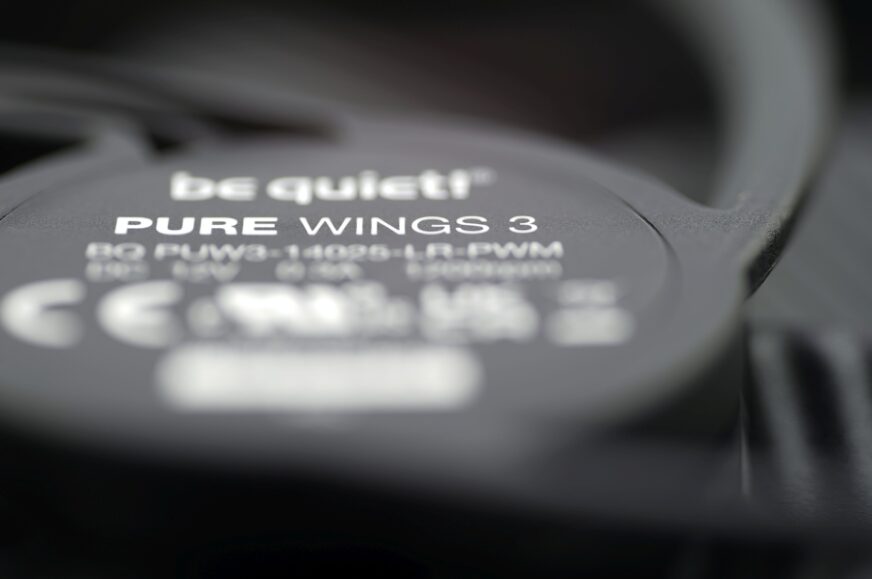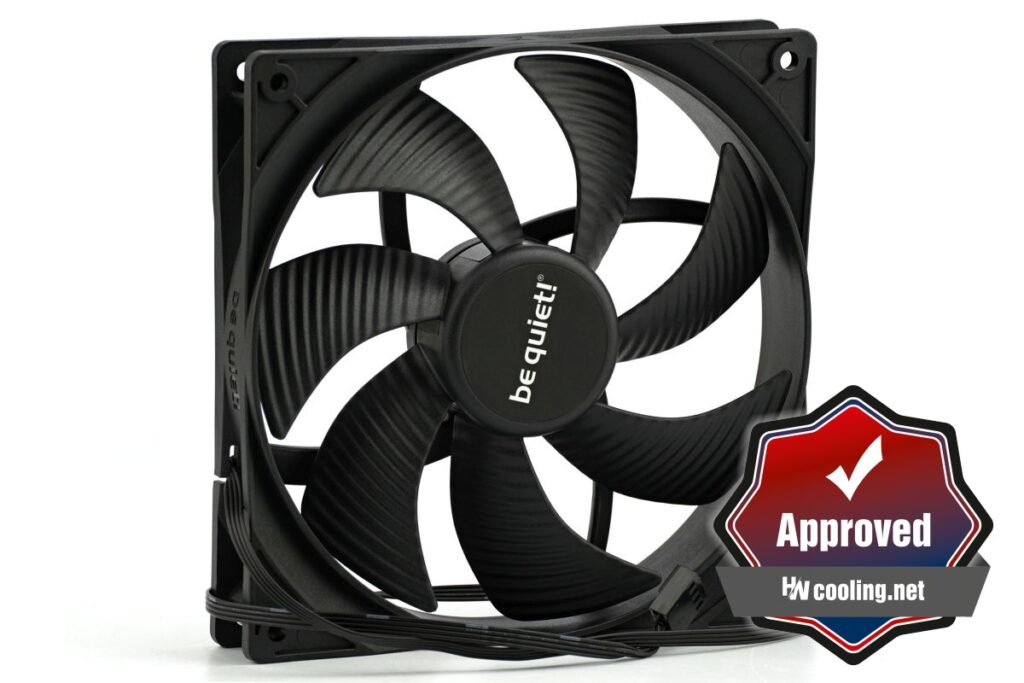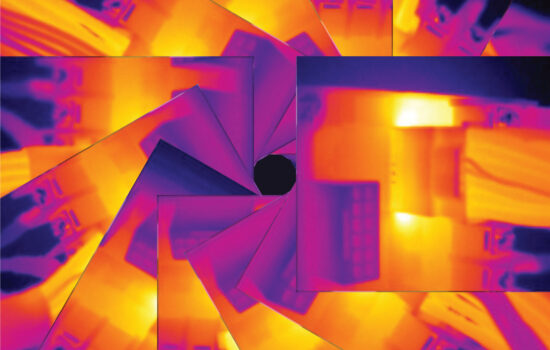Evaluation
The long break is over, back to fans. BeQuiet! recently updated its entry-level line – Pure Wings – and at least the slower 140-millimeter models have to be on your radar. The Pure Wings 3 fans in the BL108 variant represent an extremely efficient low-cost option for some situations, while not suffering from the common shortcomings of their price class. What’s quiet here is not only the aerodynamic component, but also the motor one.
Evaluation
Under optimum (non-restrictive) conditions, Pure Wings 3 (BL108) is characterized by peak performance. Without an obstacle, in terms of airflow at comparable noise levels, it easily keeps up with, for example, the 140 mm Silent Wings Pro 4, as it’s only very slightly behind it. In some modes with a plastic filter, the 7-blade Pure Wings 3 even has a bit of an edge. For these results, in addition to static pressure, the acoustic interaction with the selected obstacle also matters. That is, how much the filter increases the noise level of which fan.
Pure Wings 3 fares worst, but still decently, on the hexagonal grille. In this situation, the BeQuiet! fan is already furthest behind the competing Endorfy Fluctus 140 PWM. This is also because of the louder sound frequencies in the 300–400 Hz range. But on radiators the situation changes again. With a thinner radiator with a higher FPI, except at very low speeds (when the Fluctus is a hair better), the Pure Wings 3 is in a tight lead. In any case, both fans are equal to an extent rarely seen, even on the thicker (and thinner, 15 FPI) radiator. On it, the measured values of airflow in some modes overlap completely, and where there is a difference, it is so small that the efficiency will be determined by the force with which you tighten the fans to the radiator (with screws).
In degraded conditions, in systems with more environmental resistance, these fans will more or less drift apart, with the Pure Wings 3 being the one to go into the negative. That’s because of the significantly weaker motor, which naturally responds worse to more resistance. This is slightly different in every build and depends on the configuration and setup of all the fans running in the system.
There’s a small advantage of the Pure Wings 3 over the Fluctus 140 PWM in turn in the lower vibration. Maximum speed aside, the BeQuiet! fan is always better, or vibrates less, and overall can be commended in this regard.Sure, the Silent Wings Pro 4 is even more technically advanced in this regard, but it also sells for twice the price, and the vibrations of the PW3 at lower speeds (under 1050rpm) aren’t really something to worry about. There are some, but they are very low, especially for this type of geometry.
The blades are indeed made of “only” PBT, but BeQuiet! used a thicker material to make them strong enough in the operating speed range, so it’s all good in that respect. But yes, an even stiffer design would always be better of course, it would eliminate the tonal peaks arising due to vibrations at the blade tips. Noisier here are the lower sound frequencies between 90–140 Hz, with lower speeds also meaning lower frequencies. 90 Hz at ~720 rpm, 140 Hz practically at max speed. It (maximum speed around 1200rpm) is set quite low, which means the Pure Wings 3 will never be downright noisy, even with an overdone motherboard-level PWM curve. At the same time, however, it will never achieve a high airflow and the cooling performance, regardless of the noise level, can only be average. That is, if we’re talking about the slower variant of PW3 – BL108 (also applies to BL107). The latter, by the way, can’t deny BeQuiet!’s “genes” even when it comes to the lower speed limit – minimum via PWM is about 124 rpm. But don’t count on a passive mode.
The coefficient of airflow per watt is average, lower than the more expensive Silent Wings Pro 4. But the Pure Wings 3 boasts a significantly more favourable price-to-performance ratio, which is top-notch. For builds that have, shall we say, a tighter price ceiling, the PW3s are a very good alternative to the Endorfy Fluctus 140 PWM. The acoustic profile, which is similar, can also be decisive, always characterised to some extent by rumblier frequencies. These are a bit more pronounced at lower speeds with the BeQuiet! fan, at higher speeds (but still within the same dBA-normalized mode) with the Endorfy fan, as shown by the spectrograms. Which fan you will give priority to depends on your preferences in small details, which we have already clearly discussed.
English translation and edit by Jozef Dudáš
| BeQuiet! Pure Wings 3 (BL108) |
| + Suitable for every use case |
| + Affordable price... |
| + ... and a very attractive price/airflow ratio |
| + Cooling efficiency (airflow/pressure per unit of noise) at a very high level... |
| + ... beats even the most efficient 120 mm fans |
| + Very high efficiency even with a plastic dust filter |
| + Virtually noiseless operation of bearings and motor |
| + Very low speeds possible, stable from approx. 124 rpm |
| + Due to the lower maximum speed, it will never be noisy... |
| ... but it's at the cost of lower maximum airflow |
| - The sound is characterized by rumbling frequencies. For some, they may be unpleasant |
| - Towards the maximum speed, higher vibrations |
| - Does not have anti-vibration pads |
| - Eventual collision with a nylon dust filter |
| Approximate retail price: 15 EUR |
- Contents
- BeQuiet! Pure Wings 3 (BL108) in detail
- Overview of manufacturer specifications
- Basis of the methodology, the wind tunnel
- Mounting and vibration measurement
- Initial warm-up and speed recording
- Base 6 equal noise levels…
- ... and sound color (frequency characteristic)
- Static pressure measurement…
- … and airflow
- Everything changes with obstacles
- How we measure power draw and motor power
- Measuring the intensity (and power draw) of lighting
- Results: Speed
- Results: Airlow w/o obstacles
- Results: Airflow through a nylon filter
- Results: Airflow through a plastic filter
- Results: Airflow through a hexagonal grille
- Results: Airflow through a thinner radiator
- Results: Airflow through a thicker radiator
- Results: Static pressure w/o obstacles
- Results: Static pressure through a nylon filter
- Results: Static pressure through a plastic filter
- Results: Static pressure through a hexagonal grille
- Results: Static pressure through a thinner radiator
- Results: Static pressure through a thicker radiator
- Results: Static pressure, efficiency by orientation
- Reality vs. specifications
- Results: Frequency response of sound w/o obstacles
- Results: Frequency response of sound with a dust filter
- Results: Frequency response of sound with a hexagonal grill
- Results: Frequency response of sound with a radiator
- Results: Vibration, in total (3D vector length)
- Results: Vibration, X-axis
- Results: Vibration, Y-axis
- Results: Vibration, Z-axis
- Results: Power draw (and motor power)
- Results: Cooling performance per watt, airflow
- Results: Cooling performance per watt, static pressure
- Airflow per euro
- Static pressure per euro
- Results: Lighting – LED luminance and power draw
- Results: LED to motor power draw ratio
- Evaluation












Yay, I have been starving for HWcooling fan reviews for a while now.
The links are broken in the last page. It’s spelled bl-108 in the last page but the url of the article itself is spelled bl108.
Fixed. Thanks! 🙂
Thanks for that enormous quantity of information, now, being compared the Pure Wings 2 140mm vs Pure Wings 3 140mm which would be best ? and it would be reasonable to replace PW2 with PW3 ?
We have not tested the older Pure Wings (2) fan in 140 mm format. Some correlations and better estimates can be made after the results of the 120 mm PW3 are completed (there will be a comparison with the 120 mm PW2). Although, of course, it will not be completely accurate. With the size of the blades the character of the noise and the colour of the sound changes. And also across formats it is not just a matter of making the impeller in the 1.00:1.16 scale ratio.
Well, the results of the 140-millimeter Pure Wings 2 might be added eventually, but it’s not a big priority.